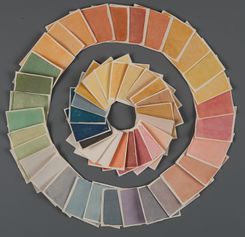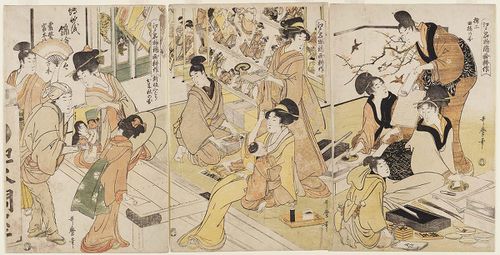Difference between revisions of "Testpage"
| (18 intermediate revisions by 2 users not shown) | |||
| Line 1: | Line 1: | ||
__NOTOC__ | __NOTOC__ | ||
| − | [[File:Colorwheel.jpg|245px|right | + | [[File:Colorwheel.jpg|245px|right]] |
'''UNDER CONSTRUCTION''':DRAFT | '''UNDER CONSTRUCTION''':DRAFT | ||
| − | + | ===Colorants=== | |
| + | A list of colorants detected so far in this research is provided below along with some of the mixture combinations. Click on each term will to see examples of the printed colors, spectra, and a list of analyzed prints. | ||
| − | This | + | This database contains the results of Japanese woodblock prints, or ''ukiyo-e'' prints from the Edo period (1603–1868) surveyed using non-invasive techniques that do not require sampling from the prints. These techniques included photography, optical microscopy, X-ray Fluorescence (XRF), Excitation Emission Matrix (EEM), Fiber Optic Reflectance (FORS) spectroscopies as well as Reflected Image Spectroscopy. |
| − | + | Please click [[More on the data|''here'']] for more information on the data. | |
| − | |||
------------------ | ------------------ | ||
| Line 47: | Line 47: | ||
*[[:Category:Prussian Blue/Orpiment: Ukiyo-e colorant|Prussian blue + Orpiment]] | *[[:Category:Prussian Blue/Orpiment: Ukiyo-e colorant|Prussian blue + Orpiment]] | ||
*[[:Category:Other Greens: Ukiyo-e colorant|Others]] | *[[:Category:Other Greens: Ukiyo-e colorant|Others]] | ||
| + | <span style="font-size:120%;><b>Orange</b></span> | ||
| + | *[[:Category:Other Oranges: Ukiyo-e colorant|Others]] | ||
<span style="font-size:120%;><b>Black</b></span> | <span style="font-size:120%;><b>Black</b></span> | ||
*[[:Category:Carbon black:Ukiyo-e colorant|Carbon black]] | *[[:Category:Carbon black:Ukiyo-e colorant|Carbon black]] | ||
| + | |||
| + | | style="width:300px; text-align:left;" | | ||
<span style="font-size:120%;><b>White</b></span> | <span style="font-size:120%;><b>White</b></span> | ||
*[[:Category:Calcium carbonate: Ukiyo-e colorant|Calcium carbonate]] | *[[:Category:Calcium carbonate: Ukiyo-e colorant|Calcium carbonate]] | ||
*[[:Category:Lead white: Ukiyo-e colorant|Lead white]] | *[[:Category:Lead white: Ukiyo-e colorant|Lead white]] | ||
| − | |||
| − | |||
<span style="font-size:120%;><b>Mica</b></span> | <span style="font-size:120%;><b>Mica</b></span> | ||
*[[:Category:Mica: Ukiyo-e colorant|Mica]] | *[[:Category:Mica: Ukiyo-e colorant|Mica]] | ||
| Line 107: | Line 109: | ||
*[[:Category:Torii Kiyohiro (鳥居清広) active 1737–1776|Torii Kiyohiro]] | *[[:Category:Torii Kiyohiro (鳥居清広) active 1737–1776|Torii Kiyohiro]] | ||
*[[:Category:Torii Kiyomasu I (鳥居清倍) active about 1696–1716|Torii Kiyomasu I]] | *[[:Category:Torii Kiyomasu I (鳥居清倍) active about 1696–1716|Torii Kiyomasu I]] | ||
| − | *[[:Category:Torii Kiyomasu II ( | + | *[[:Category:Torii Kiyomasu II (二代目鳥居清倍) 1706–1763|Torii Kiyomasu II]] |
*[[:Category:Torii Kiyomitsu I (鳥居清満) 1735–1785|Torii Kiyomitsu I]] | *[[:Category:Torii Kiyomitsu I (鳥居清満) 1735–1785|Torii Kiyomitsu I]] | ||
*[[:Category:Torii Kiyonaga (鳥居清長) 1752–1815|Torii Kiyonaga]] | *[[:Category:Torii Kiyonaga (鳥居清長) 1752–1815|Torii Kiyonaga]] | ||
| Line 121: | Line 123: | ||
*[[:Category:Utagawa Kunisada, Toyokuni III (歌川国貞・三代目歌川豊国) 1786–1864|Utagawa Kunisada (Toyokuni III)]] | *[[:Category:Utagawa Kunisada, Toyokuni III (歌川国貞・三代目歌川豊国) 1786–1864|Utagawa Kunisada (Toyokuni III)]] | ||
*[[:Category:Utagawa Kuniyoshi (歌川国芳) 1797–1861|Utagawa Kuniyoshi]] | *[[:Category:Utagawa Kuniyoshi (歌川国芳) 1797–1861|Utagawa Kuniyoshi]] | ||
| − | *[[:Category:Utagawa | + | *[[:Category:Utagawa Toyoharu (歌川豊春) 1735–1814|Utagawa Toyoharu]] |
*[[:Category:Utagawa Toyokuni I (歌川豊国) 1769–1825|Utagawa Toyokuni I]] | *[[:Category:Utagawa Toyokuni I (歌川豊国) 1769–1825|Utagawa Toyokuni I]] | ||
| Line 189: | Line 191: | ||
=== Bibliography=== | === Bibliography=== | ||
| − | [[Bibliography|'''A list of publications and resources''']] on | + | [[Bibliography|'''A list of publications and resources''']] on colorants found in Japanese woodblock prints. |
=== About the Collection === | === About the Collection === | ||
| Line 195: | Line 197: | ||
[[File:SC206467.jpg|500px|right|link=https://collections.mfa.org/objects/497727|Woodblock Printer, Print Shop, Distributing New Prints by Kitagawa Utamaro]] | [[File:SC206467.jpg|500px|right|link=https://collections.mfa.org/objects/497727|Woodblock Printer, Print Shop, Distributing New Prints by Kitagawa Utamaro]] | ||
| − | The MFA has over 50,000 Japanese prints and approximately 3,000 titles of illustrated books covering the Edo period (1603–1868) to the present. The Japanese woodblock print collection spans the Edo period from its birth to color printing to its height as a commercial product and to its end in the Meiji period (1868–1912). This collection represents not only the breadth of artists working at the time but also multiple impressions and editions, making it a comprehensive resource for scholarship, research, and teaching. Collections from prominent Bostonians such as William Sturgis Bigelow, Denman Ross, and the Spaulding brothers at the turn of the century form the basis of the collection. Furthermore, the [https://collections.mfa.org/search/Objects/ | + | The MFA has over 50,000 Japanese prints and approximately 3,000 titles of illustrated books covering the Edo period (1603–1868) to the present. The Japanese woodblock print collection spans the Edo period from its birth to color printing to its height as a commercial product and to its end in the Meiji period (1868–1912). This collection represents not only the breadth of artists working at the time but also multiple impressions and editions, making it a comprehensive resource for scholarship, research, and teaching. Collections from prominent Bostonians such as William Sturgis Bigelow, Denman Ross, and the Spaulding brothers at the turn of the century form the basis of the collection. Furthermore, the [https://collections.mfa.org/search/Objects/classifications%3APrints%3Bcreditline%3A%22William%20S.%20and%20John%20T.%20Spaulding%20Collection%22%3BcollectionTerms%3AAsia/* William S. and John T. Spaulding Collection] of Japanese woodblock prints is a study collection comprised of over 6,000 prints that generally display remarkable preservation of the colorants, making it a valuable benchmark for the study of color and palette. |
==== Acknowledgement ==== | ==== Acknowledgement ==== | ||
Revision as of 10:50, 26 April 2025
UNDER CONSTRUCTION:DRAFT
Colorants
A list of colorants detected so far in this research is provided below along with some of the mixture combinations. Click on each term will to see examples of the printed colors, spectra, and a list of analyzed prints.
This database contains the results of Japanese woodblock prints, or ukiyo-e prints from the Edo period (1603–1868) surveyed using non-invasive techniques that do not require sampling from the prints. These techniques included photography, optical microscopy, X-ray Fluorescence (XRF), Excitation Emission Matrix (EEM), Fiber Optic Reflectance (FORS) spectroscopies as well as Reflected Image Spectroscopy.
Please click here for more information on the data.
|
Blue Red |
Yellow Brown Purple |
Green Orange Black |
White Mica Metallic |
By Artist
Prints analyzed listed by artist.
Bibliography
A list of publications and resources on colorants found in Japanese woodblock prints.
About the Collection
The MFA has over 50,000 Japanese prints and approximately 3,000 titles of illustrated books covering the Edo period (1603–1868) to the present. The Japanese woodblock print collection spans the Edo period from its birth to color printing to its height as a commercial product and to its end in the Meiji period (1868–1912). This collection represents not only the breadth of artists working at the time but also multiple impressions and editions, making it a comprehensive resource for scholarship, research, and teaching. Collections from prominent Bostonians such as William Sturgis Bigelow, Denman Ross, and the Spaulding brothers at the turn of the century form the basis of the collection. Furthermore, the William S. and John T. Spaulding Collection of Japanese woodblock prints is a study collection comprised of over 6,000 prints that generally display remarkable preservation of the colorants, making it a valuable benchmark for the study of color and palette.
Acknowledgement
The colorant research comes out of a long collaboration between the Asian Conservation Studio and Scientific Research Laboratory that was led by Joan Wright and Michele Derrick. We would like to thank the many volunteers who contributed to this research. We are also grateful to Richard and JoAnn Pinkowitz for donating to this database project which allowed us to bring the Ukiyo-e Print Colorant Database online.

